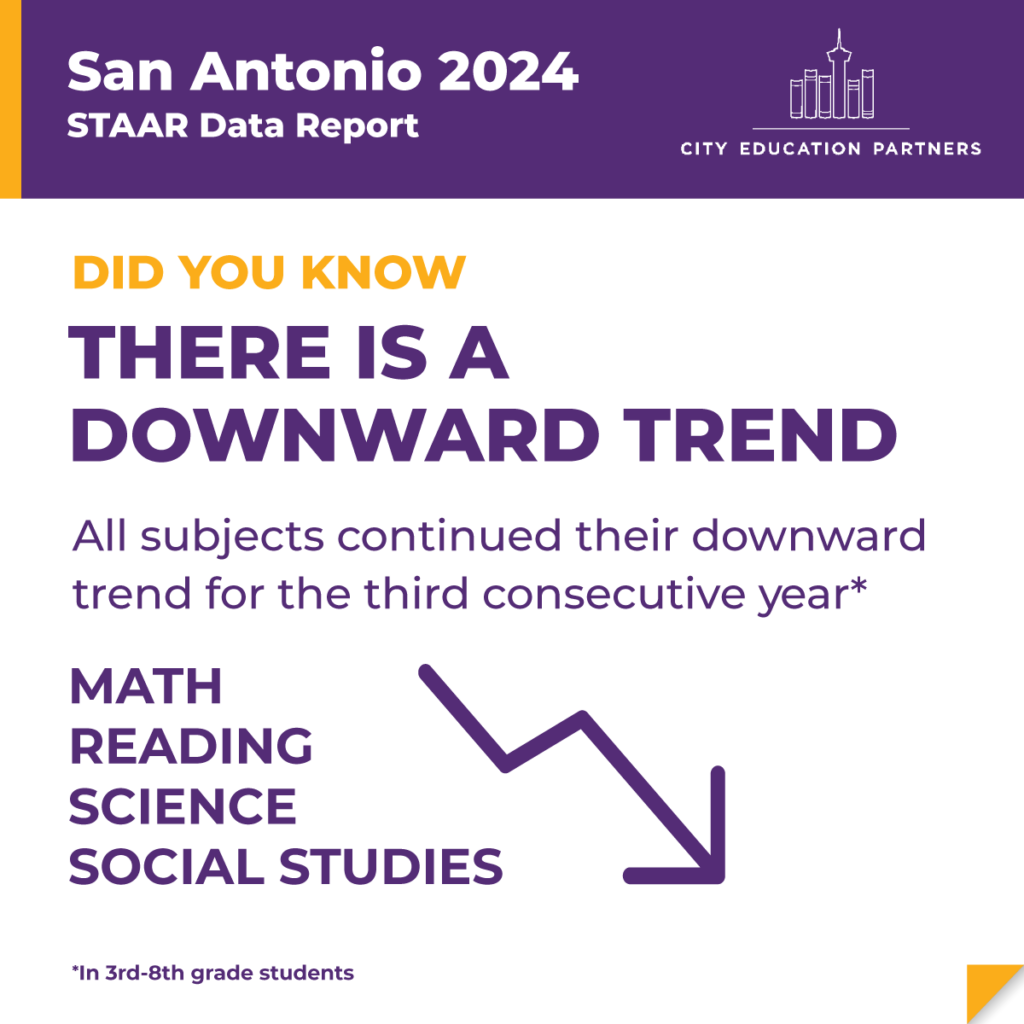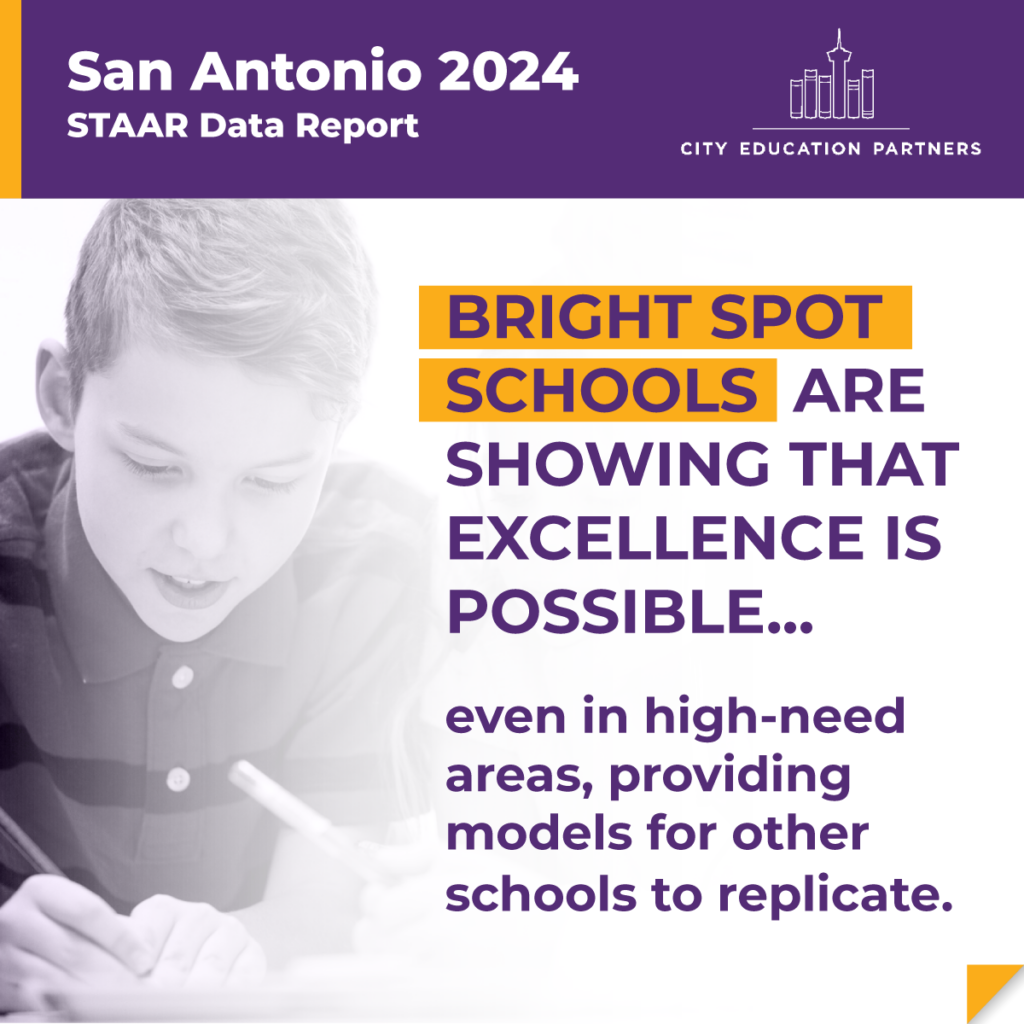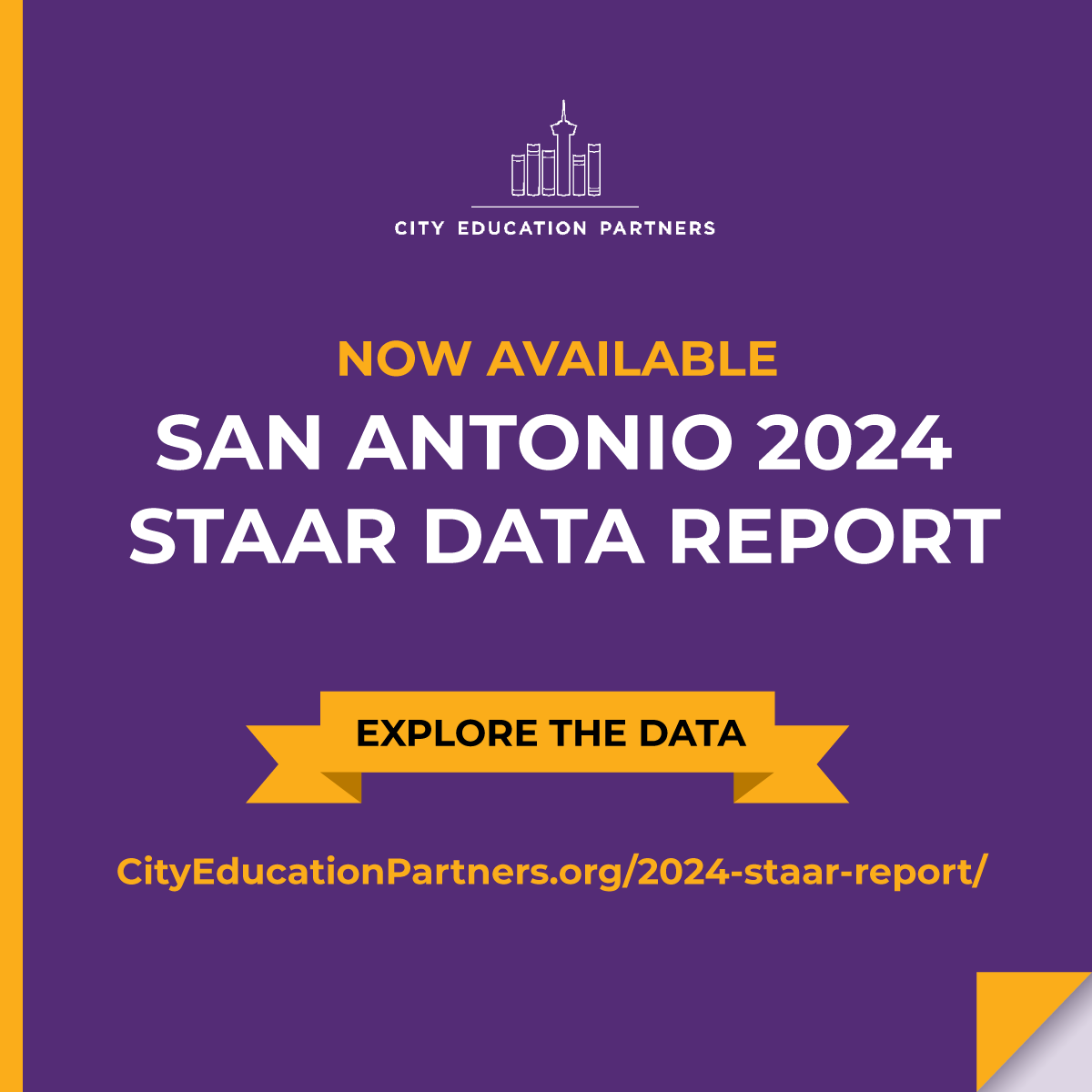
Can children in San Antonio read and do math on grade level? According to the San Antonio STAAR Data Report from City Education Partners (CEP), for a majority of children, the answer is no. CEP released their 2024 report today, and it shows that just 46 percent of students in grades 3–8 scored “Meets Grade Level” or above on the 2023–24 STAAR tests in reading. The report also shows that just 31 percent of those students were at or above grade level in math.
We have created this guide to the 2024 San Antonio STAAR Data Report to help you examine the data and understand why we should be concerned about the current downward trend. In addition, we want to highlight bright spots in the report, such as schools that are showing high scores for students from economically disadvantaged backgrounds. Finally, we want to encourage our community of families, parents, and caregivers to get involved and find ways to support our students’ success.
Quick Links
If you want to dive right into CEP’s 2024 San Antonio STAAR Data Report, here are some important links.
- Executive Summary (one page)
- Full Report (54 pages)
- Tableau—Data Analysis Tool
- STAAR Data Report Web Page
- City Education Partners Home Page
- Social Media: Follow CEP on Facebook, Instagram, and X (Twitter)

Examining the Data
In order to make progress, first we need to understand where we stand now. That’s why for years we have been helping families read their own children’s STAAR report cards and use them as tools for communicating with teachers. CEP’s San Antonio STAAR Data Report takes that principle and applies it citywide.
Unfortunately, the 2024 STAAR Data Report shows that a majority of children in San Antonio can’t read or do math on grade level. Using 2023–24 data from the Texas Assessment Research Portal, CEP analyzed STAAR reading and math scores for students in San Antonio’s 10 city council districts to identify how many students scored at “Meets Grade Level” or above. (Find more notes about the analysis on pp. 52–53 of the report.) Here are some key points:
- For reading, only 46 percent of students scored at or above grade level in 2023–24.
- Reading scores only improved by one percent between 2022–23 and 2023–24; the overall trend is essentially flat since 2017–18.
- For math, only 31 percent of students scored at or above grade level in 2023–24.
- Math scores decreased by two percent between 2022–23 and 2023–24; they are down 13 percent since 2017–18.
For people like us who love San Antonio, this data raises some disturbing questions. Given how students are performing on standardized tests now, will many of those students be ready for enrolling in college and entering the workforce when they become adults? Also, comparing different city council districts, why are there such wide gaps between economically disadvantaged areas and wealthier areas? With these flat or downward trends, will San Antonio continue to lag behind other large metropolitan areas in Texas in educational attainment?

Bright Spots in the STAAR Data Report
It’s important to always remember that students from all corners of San Antonio have the potential to succeed. The STAAR Data Report helps us remain hopeful because it identifies schools that are helping students from economically disadvantaged backgrounds to succeed academically. CEP’s report calls these schools “bright spots” and sorts them by San Antonio City Council district. Not sure which district you live in? Use the Find My Council Member tool, or find out who represents you.
District 1 Bright Spots
In District 1, 46 percent of students are at or above grade level in reading, and 29 percent in math.
CEP considers these choice schools to be bright spots in District 1:
- KIPP Somos Collegiate in KIPP Texas Public Schools
- Bonham Academy and Cotton Academy in SAISD Choice Schools
- Somerset Academy Lone Star in Somerset Academy of Texas
In addition, the report shows that the top performing open enrollment charter schools in District 1 are BASIS San Antonio Primary—North Central, Great Hearts Monte Vista, and TriPoint Academy.
The top performing in-district charter schools in District 1 are Twain Dual Language Academy and Advanced Learning Academy in SAISD Choice Schools. Note that Bonham Academy, Cotton Academy, and Twain Dual Language Academy were impacted by SAISD Rightsizing (specifically, by mergers and expansions at Green Elementary, Beacon Hill Academy, and Gonzales Early Childhood Center, respectively) between 2023–24 and 2024–35.
District 2 Bright Spots
In District 2, 40 percent of students are at or above grade level in reading, and 25 percent in math. CEP considers these choice schools to be bright spots in District 2:
- IDEA Carver, IDEA Eastside, and IDEA Najim in IDEA Public Schools.
- Cameron Elementary in SAISD Choice Schools
In addition, the top performing in-district charter schools in District 2 are Young Women’s Leadership Academy Primary at Page and Young Men’s Leadership Academy in SAISD Choice Schools. The report shows that Gates Elementary and Lamar Elementary were relatively high performing schools, but the district closed those campuses after the 2023–24 school year due to SAISD Rightsizing.
District 3 Bright Spots
In District 3, 35 percent of students are at or above grade level in reading, and 23 percent in math. CEP considers these choice schools to be bright spots in District 3:
- Highland Forest Elementary and Salado Elementary in East Central ISD Schools of Choice
- IDEA South Flores in IDEA Public Schools
In addition, the report shows that the set of top performing open enrollment charter schools in District 3 also includes Somerset Academy Brooks.
The top performing in-district charter schools in District 3 include Steele Montessori in SAISD Choice Schools. (Steele Montessori changed locations between the 2023–24 and 2024–25 school years due to SAISD Rightsizing but is still located in District 3.)
District 4 Bright Spots
In District 4, 36 percent of students are at or above grade level in reading, and 26 percent in math. CEP considers these choice schools to be bright spots in District 4:
- Harmony School of Excellence in Harmony Public Schools
- IDEA Brackenridge and IDEA Ewing Halsell in IDEA Public Schools
In addition, the report shows that the set of top performing open enrollment charter schools in District 4 includes Greg A. Garcia Early College Intermediate in New Frontiers Public Schools. There are no notable in-district charter schools in District 4.
District 5 Bright Spots
In District 5, 29 percent of students are at or above grade level in reading, and 18 percent in math. CEP considers these choice schools to be bright spots in District 5:
- Loma Park Elementary and Perales Elementary in Edgewood ISD Schools of Innovation
- Prelude Prep
- Irving Dual Language Academy, Green Elementary, and Kelly Elementary in SAISD Choice Schools
In addition, the report shows that the top performing open enrollment charter schools in District 5 are KIPP Aspire Academy, KIPP Camino Academy, and KIPP Esperanza Primary in KIPP Texas Public Schools.
The top performing in-district charter schools in District 5 are Roy Cisneros Leadership School for Boys and Las Palmas Leadership School for Girls in Edgewood ISD Schools of Innovation, and Briscoe Elementary (an IB school) and Rodriguez Montessori Elementary in SAISD Choice Schools. Note that after the 2023–24 school year Green Elementary and Kelly Elementary were affected by SAISD Rightsizing: Green relocated to the Riverside Park campus, and Kelly merged with Lowell Middle School.
District 6 Bright Spots
In District 6, 47 percent of students are at or above grade level in reading, and 29 percent in math. CEP considers these choice schools to be bright spots in District 6:
- IDEA Hidden Meadow, IDEA Mays, and IDEA Monterrey Park in IDEA Public Schools
In addition, the report shows that the top performing open enrollment charter schools in District 6 are BASIS San Antonio—Jack Lewis Jr., Great Hearts Western Hills, and Harmony Science Academy. There are no notable in-district charter schools in District 6.
District 7 Bright Spots
In District 7, 44 percent of students are at or above grade level in reading, and 28 percent in math. CEP considers IDEA Ingram Hills in IDEA Public Schools to be a bright spot in District 7.
In addition, the report shows that the top performing open enrollment charter schools in District 7 are Anne Frank Inspire Academy, School of Science and Technology—Hill Country, Somerset Academy Oaks, and Valor San Antonio.
The top performing in-district charter school in District 7 is Young Women’s Leadership Academy Secondary in SAISD Choice Schools. The report mentions Baskin Elementary as a bright spot, but that school closed after the 2023–24 school year due to SAISD Rightsizing.
District 8 Bright Spots
In District 8, 62 percent of students are at or above grade level in reading, and 46 percent in math. There are no choice schools in District 8 that meet the criteria for bright spots.
The report shows that the top performing open enrollment charter schools in District 8 are BASIS San Antonio—Shavano and BASIS San Antonio Primary—Medical Center in BASIS Texas Charter Schools and Great Hearts Forest Heights. There are no in-district charter schools in District 8.
District 9 Bright Spots
In District 9, 72 percent of students are at or above grade level in reading, and 55 percent in math. There are no schools in District 9 that meet the criteria for bright spots. The report shows that the top performing open enrollment charter school in District 9 is EKHLA. There are no in-district charter schools in District 9.
District 10 Bright Spots
In District 10, 56 percent of students are at or above grade level in reading, and 39 percent in math. CEP considers IDEA Judson in IDEA Public Schools to be a bright spot in District 10.
In addition, the report shows that the top performing open enrollment charter schools in District 10 are BASIS San Antonio—Northeast, Great Hearts Northern Oaks, and School of Science and Technology—Alamo and School of Science and Technology—San Antonio College Prep High School in School of Science and Technology Public Schools. There are no in-district charter schools in District 10.
Visit the STAAR Data Report for full listings of bright spot schools, including traditional zoned neighborhood public schools. Does it seem like the school you are looking for is missing? Because CEP’s STAAR Data Report is designed to focus on schools within the boundaries of the City of San Antonio, it excludes campuses in other municipalities such as Alamo Heights, Balcones Heights, and Castle Hills. To cast a wider net, you can check our schools guide or try other search tools such as txschools.gov.

Action Steps for Families, Parents, and Caregivers
Now that you’ve seen the data, you probably feel concerned about the state of education in San Antonio. Are our schools preparing students for the jobs of the future, and for the degrees and certifications they will need to fill those jobs? By looking at the bright spots and the top performing schools, we know that progress is possible.
What can families, parents, and caregivers do to help our children reach their full potential? The STAAR data report makes these recommendations.
- Track your own children’s progress. We recommend looking up STAAR report cards and using them as tools for communicating with teachers.
- Help your children attend school as much as possible. You can find school attendance data in CEP’s data analysis tool.
- Work with your children’s teachers and support their well being. Supporting teachers includes being an education advocate and understanding school finance.
CEP’s report also suggests action steps for school leaders, school board members, business leaders, elected officials, and community organizations. We all need to work together to help every student in our community get access to a great education.
In the interest of full disclosure, we should note that CEP is a financial supporter of San Antonio Charter Moms.
Charter Moms Chats
Watch Dalia Flores Contreras, Chief Executive Officer at City Education Partners, and Jennifer Limas-Mota, Communications Director at City Education Partners, speak with Inga Cotton on Charter Moms Chats on October 3, 2024 at 2:30 PM Central live on Facebook and YouTube.
Dalia Flores Contreras is the Chief Executive Officer at City Education Partners. Contreras grew up on the Westside of San Antonio and is a graduate of both Palo Alto College and the University of Texas at San Antonio. She holds a Bachelor of Interdisciplinary Studies and a Master of Educational Leadership and Policy Studies from UTSA. She has over 20 years of experience in education and has served in a variety of roles—from classroom teacher to superintendent of schools. She had the opportunity to study, learn and work in the education ecosystem of Texas, Illinois and Oklahoma in both district and charter public school systems.
Jennifer Limas-Mota is the Communications Director at City Education Partners. Jennifer has senior level expertise in strategic communications, advocacy, and project management. Jennifer has spent her professional career working alongside mission driven organizations who make an impact. She has previously served in leadership roles for New Frontiers Public Schools, Texas Public Charter Schools Association, Texas CASA, and the Texas Criminal Justice Coalition. A native South Texan and proud University of Texas graduate, Jennifer is passionate about empowering underserved communities access to quality public education.
Read More About Data on Schools in San Antonio
- “Fewer than a third of San Antonio students are on grade level in math. Can you help?” Isaac Windes, San Antonio Report, September 26, 2024
- “How to Find the Best Schools in San Antonio,” San Antonio Charter Moms, September 20, 2024
- “Find Objective Information About School Quality in the Texas Assessment Research Portal,” San Antonio Charter Moms, September 20, 2024
- “Step-by-Step Instructions for STAAR Report Cards and Resources,” Inga Cotton, San Antonio Charter Moms, June 14, 2024
